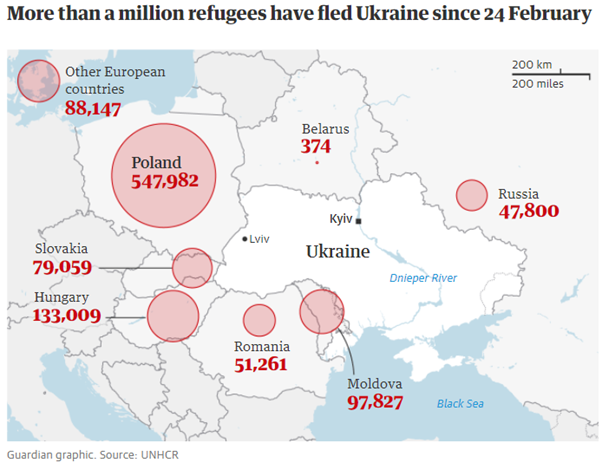Below are excerpts from two Guardian articles. This Quibans records the things my class and I did with the articles.
From The Guardian – 3 March 2022
Ukraine’s refugees: how many are displaced and where will they go?
Domestic civilian flights were cancelled on the first day of the invasion. Since then, people have been heading west into neighbouring countries including Poland, Romania, Moldova and Hungary.
More than half – nearly 548,000 – have fled to Poland which shares a 500km border with Ukraine. A further 133,000 have gone to Hungary, 72,000 to Slovakia, 51,260 to Romania, and nearly 98,000 to non-EU Moldova, Europe’s poorest country. A small number, just over 350, have travelled to Belarus.
From The Guardian – 8 March 2022
Britain should refrain from criticising Ireland’s open-door policy towards Ukrainian refugees, an influential Conservative MP has said, after anonymous briefings claimed it was creating a security risk for the UK.
The Irish government minister Roderic O’Gorman told RTÉ’s Morning Ireland that giving shelter to refugees was “the right thing to do”, revealing that 2,200 Ukrainians had arrived in the country since Russia invaded on 24 February, compared with about 300 in the UK.
Possible questions:
- Comment on the countries refugees are going to.
- Are the numbers on the map and in the article consistent?
- Are the numbers accurate?
- Which country is supporting the most refugees? (Why is it not necessarily the ‘obvious’ answer of Poland?)
- What percentage of the refugees are in each country?
- What is the connection between the circles and the number of refugees?
.
.
.
.
.
.
Answers:
1) Comment on the countries refugees are going to.
Those listed are the countries immediately surrounding Ukraine. This is not a surprise, because flights to/from Ukraine are not currently possible, so to leave Ukraine you need to enter a neighbouring country. Many people will want to return home as soon as possible and won’t want to travel further. Some might have family in those neighbouring countries. Given that they are safe in those countries it would be understandable if people didn’t want to travel further. The number of refugees in Belarus is tiny. But Belarus is supporting Russia in their invasion. Perhaps a bigger surprise is the number in Russia; they are presumably ethnic Russians who were living in Ukraine.
2) Are the numbers on the map and in the article consistent?
Largely, yes.
Rounding has mostly been carried out appropriately. The only exception is that Slovakia’s figure
from the map has been wrongly stated in the article. Interestingly, almost all of the values have been
rounded up. The biggest round-down
number is for Belarus!
3) Are the numbers accurate?
I have no idea!
How do you accurately count over a million people? The source for the
data is the UNHCR (The United Nations High Commission for Refugees) and they presumably
have a sensible and consistent methodology that they use in different
countries.
The interesting ones are that three of the numbers
end in 00, which perhaps suggests they have been given as approximations. One of these is for Russia, which seems to
make sense too, given that they are not cooperating with the international community particularly well at the moment ...
4) Which country is supporting the most refugees? (Why is it not necessarily the ‘obvious’ answer of Poland?)
Maybe it would be better to compare the number of
refugees to the population of each country?
Here are some calculations that I carried out in
Excel:
|
|
No. of refugees |
Population |
Refugees / population |
% of the refugees |
|
Poland |
547982 |
37,846,605 |
0.014479027 |
52.42% |
|
Slovakia |
79059 |
5,459,643 |
0.014480617 |
7.56% |
|
Hungary |
133009 |
9,660,350 |
0.013768549 |
12.72% |
|
Romania |
51261 |
19,237,682 |
0.002664614 |
4.90% |
|
Moldova |
97827 |
4,033,963 |
0.024250842 |
9.36% |
|
Russia |
47800 |
145,934,460 |
0.000327544 |
4.57% |
|
Belarus |
374 |
9,449,321 |
3.95796E-05 |
0.04% |
|
Other Europe |
88147 |
|
|
8.43% |
|
|
|
|
|
|
|
Ireland |
2200 |
4,937,796 |
0.000445543 |
0.21% |
|
United Kingdom |
300 |
67,886,004 |
4.41917E-06 |
0.03% |
Moldova has the most per population. Slovakia is almost identical to Poland. (We also discussed what the values for
Belarus and the UK mean.)
5) What percentage of the refugees are in each country?
See the table above.
6) What is the connection between the circles and the number of refugees?
I copied the graph into GeoGebra and drew line segments to measure the approximate diameter of each circle. When I divided the number of refugees by the area of the circle I got similar answers (roughly 160,000) each time, suggesting that the areas of the circles show the values.
Sources:




